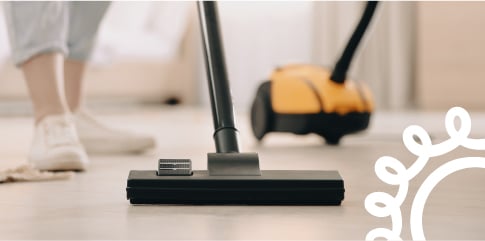Beware of the dog... allergy
Man’s best friend? Whether you’re a man or a woman, that friendship will certainly be tested if you have an allergy to dogs. Did you know that it’s estimated that one in four European adults has an allergy to dogs or cats? This allergy is likely to run in the family, and there are all kinds of uncomfortable allergic reactions. From a runny nose, swelling and itching around the eyes or nose, to skin rashes and in very extreme cases breathing difficulties, which can lead to asthma.
You won’t have to wait long to find out if you’re allergic. Generally, the symptoms will start around 30 minutes after contact with a dog or its hairs. This can also include redness of the skin after being licked by a dog.
Many people believe that some dog breeds trigger allergies, while others don’t. For example, that short-haired dogs are safe but long-haired varieties are more likely to cause allergies. This is in fact a “shaggy dog” story! The truth is more surprising, two dogs of the same breed can cause an entirely different allergic reaction. So, why is this? Well, the problem isn’t the dog’s hair at all, it’s the dander, which is the flakes of shed skin in the dog’s hair. Also, saliva, urine and sweat in the hair can be causes.
It was thought that exposing a young child to a dog could cause them to develop a pet allergy. However, various scientific studies have proved the opposite to be true. That in fact, being around a dog seems to build up a child’s resistance to an allergic reaction.
What should you do if you have an allergy to dogs? The best thing is to not have a dog. Easily said, but if you love dogs, or live with them, this is just not an option. And what’s the second-best thing you can do? There are many options, check out which ones that work best for your situation.
Seven great tricks to live with your dog allergy
- The first thing to do: make sure you’re barking up the right tree. You might be 100% sure that you have an allergy to dogs, but it’s still a good idea to get yourself tested by your doctor. Why? You might not have a dog allergy at all, but instead, an allergy to pollen or mould that the dog is carrying on its coat from outside.
- You might love having your dog on the bed, but considering how much time you spend there, it isn’t a good place if you have an allergy. Create some dog free areas to protect yourself. Ever better, let them out as much as possible. Which of course, your dog loves too.
- Mop, clean, sweep and vacuum on a regular basis. This reduces the amount of dog dander, dust mites and other allergens.
- Consider using a vacuum cleaner with a HEPA filter. The HEPA (High Efficiency Particulate Air) filter can remove most of all dust, hairs and dander. Maybe even as much as 99%.
- Your existing central heating and air conditioning system can actually aggravate your allergy. By spreading the dog dander to every room, even where your pal isn’t even allowed. Buy a central air purifier to filter household air. There are some models that can take care of the whole home, but they can be expensive. Do a little online research to see what fits your budget.
- Think ahead. If you have guests coming with a dog, take your anti-allergy medicine a couple of weeks in advance. And try to keep a distance when you’re with the dog.
- There are many ways to treat an allergy to dogs, which you can purchase at your local chemist. Antihistamines which can block the effects, decongestants to relieve swelling and nasal steroids, which can relieve the symptoms. If your allergy is severe, you can also discuss anti-allergy injections with your doctor for a referral to an allergy/immunology specialist.










